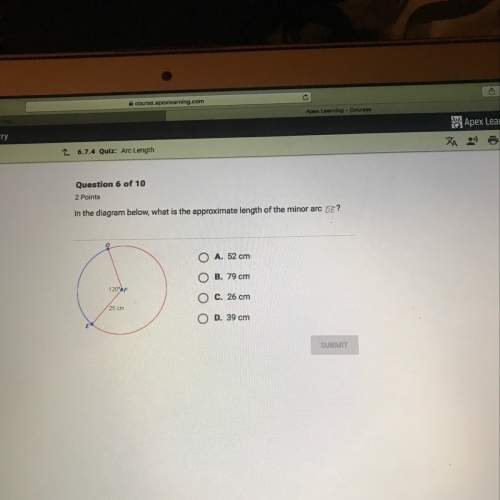
Mathematics, 25.06.2019 02:00 slhfbfjcys
An ordinary (fair) die is a cube with the numbers 1 through 6 on the sides (represented by painted spots). imagine that such a die is rolled twice in succession and that the face values of the two rolls are added together. this sum is recorded as the outcome of a single trial of a random experiment. compute the probability of each of the following events: event a : the sum is greater than 6. event b : the sum is an odd number.

Answers: 3
Another question on Mathematics

Mathematics, 21.06.2019 15:30
The function ƒ is defined by ƒ(x) = (x + 3)(x + 1). the graph of ƒ in the xy-plane is a parabola. which interval contains the x-coordinate of the vertex of the graph of ƒ?
Answers: 2

Mathematics, 21.06.2019 20:00
Put the equation in slope intercept form by solving for y
Answers: 2

Mathematics, 21.06.2019 21:00
Use the following random list of 100 numbers and the same assignations as in the example (0-4 represent girls and 5-9 represent boys) to answer the questions below. 3199 9288 1023 1130 0809 1770 6231 7538 8927 4761 7258 7111 0209 0916 1450 9848 4654 7579 6150 3093 9608 0061 4014 9501 0382 3052 2385 9074 1664 6551 6577 1811 3454 5870 1277 5056 1063 5697 9141 4120 9181 1343 0168 3693 0463 4842 1704 3774 4908 4161 6404 9675 2518 3988 4268 6083 0636 9634 5295 5656 1918 3133 6831 8393 6363 2452 1531 1638 1317 2279 9395 0702 2091 5269 0422 0275 3373 1424 1958 0356 5163 0743 6658 6257 2772 0570 4522 2665 0890 3560 5549 2238 2172 9715 9741 4975 6617 9034 4441 8220 based on the results of the second simulation, what is the experimental probability that a group will include only boys? based on the results of the second simulation, what is the experimental probability that a group will not contain four boys?
Answers: 2

Mathematics, 21.06.2019 22:30
Solve: 25 points find the fifth term of an increasing geometric progression if the first term is equal to 7−3 √5 and each term (starting with the second) is equal to the difference of the term following it and the term preceding it.
Answers: 1
You know the right answer?
An ordinary (fair) die is a cube with the numbers 1 through 6 on the sides (represented by painted s...
Questions
















History, 11.01.2020 03:31








